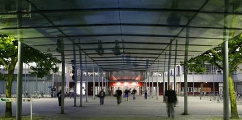CeBiTec Colloquium: 2009/01/05 Dr. Antonio Lagares, IBBM - Instituto de Biotecnología y Biología Molecular, Facultad de Ciencias Exactas - National Research Council (CONICET), Universidad Nacional de La Plata, Argentina
2009/01/05, 17:15
CeBiTec Laboratory Building, Room G2-104
Adaptation of rhizobia to challenging environments: several actors, several answers, short- and long-term mechanisms of adaptation
Abstract:
Rhizobia that associate with alfalfa in agricultural soils of Argentina include Sinorhizobium meliloti, the natural N2-fixing symbiont of Medicago spp., and isolates related to the previously described Or191-like rhizobia. During the last years, in our group we have studied different aspects of the response of both types of bacteria to a model environmental stress (acidity) in order to evaluate how rhizobia accommodate in the short term to an abiotic extracellular challenge that operates in of some of our local fields. I will present a summary of the main behavioral and genetic differences between both types of rhizobia, focusing in their nodulation properties, nodulation clusters, and responses to acidity.
Other interest of our group has focused the genetic mechanisms that mediate horizontal gene transfer in rhizobia as a mean to evolve and accommodate in the mid-term to the changing soil conditions. In this context, we have constructed a consolidated collection of S. meliloti isolates attempting to characterize the incidence, diversity, and functional properties of plasmid conjugal functions within the local population, and within the species. I will present some general characteristics of the S. meliloti cryptic plasmid mobilome, and data on the structure of some replication and mobilization cassettes present in our plasmids collection which appear to be geographically widely distributed. Results will be discussed in the frame of current knowledge on the evolution of the Medicago symbionts.



